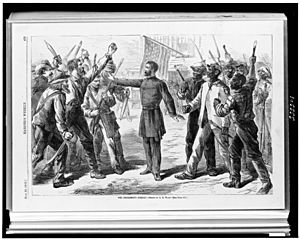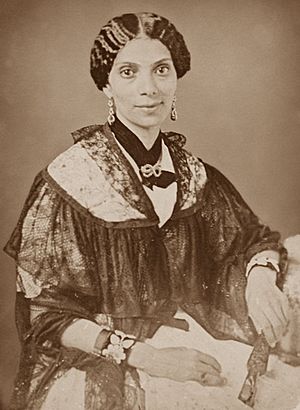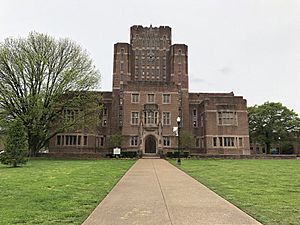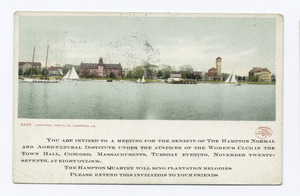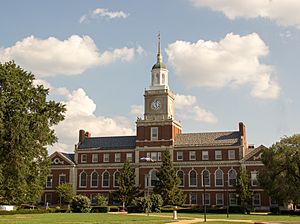Freedmen's Schools facts for kids
Freedmen Schools were special schools created between 1863 and 1870. They started right after slavery ended in the United States. Many people who had been enslaved, called freedmen, found it hard to get a good education. This was because some people still opposed equality between black and white people.
These schools were mainly for African Americans. However, anyone could attend them, no matter their race. Freedmen Schools were not perfect, but they gave many African Americans hope. They also opened up new opportunities for their future.
To help freed people learn and grow, education was very important. The government created the Freedmen's Bureau to support freedmen. After a few years, this Bureau focused mostly on education. That's how these schools became known as Freedmen Schools. Unlike regular public schools, Freedmen Schools did not get much government money. They relied on donations, community taxes, and help from churches to keep going.
Many people believed African Americans needed to learn how to be "American" citizens. This idea brought supporters together to create these schools. Freedmen Schools started years before the "separate but equal" Jim Crow laws were made. These laws later forced black and white students into separate schools. Freedmen Schools were an early step in changing school systems. They also showed the growing disagreements about education.
Contents
How Freedmen Schools Started
Help from Churches
After slavery ended in the United States, churches and kind people from the North started many schools. This happened even before the government decided to help with education. In September 1861, the American Missionary Association (AMA) opened one of the first Freedmen Schools in Virginia. They began an important historical effort.
The AMA focused on two main goals: ending slavery and doing missionary work. Because of this, some people accused the churches of trying to force their beliefs on students. But this idea was later proven wrong.
Despite strong opposition, the AMA kept supporting education for freedmen. They took over resources from other groups that had stopped helping. The AMA provided teachers, money, and places for schools. However, their support could not last forever. The AMA eventually had to reduce most of its help. Still, its school board members and teachers continued to offer what support they could.
The AMA's generosity helped provide education at all levels, from elementary to college. Their efforts continued to influence schools even after Freedmen Schools ended. This influence lasted into the era of "separate but equal" schools.
The Freedmen's Bureau
The Freedmen's Bureau was another group that greatly helped freedmen's education. The U.S. Congress created the Freedmen's Bureau in 1865. Its job was to help African Americans in the South. It was a temporary government aid program. It aimed to help recently freed individuals and families in general. It only lasted for six years.
In 1866, the Freedmen Bureau Act provided strong government support for education. This law directed most of the Bureau's help towards schools. With this new goal, the Freedmen's Bureau guided education. Assistant commissioners from the Bureau appointed superintendents. They also gave discounted food to teachers. This helped improve the school system and encourage support.
With the Bureau's help, Freedmen Schools grew and became successful. But this success was only for a short time. In 1872, the Freedmen's Bureau closed down. Because of the Bureau's strong efforts in education, many states decided that segregation was no longer necessary. They began funding public schools where all students could learn together. Freedmen Schools ended after this. However, the structure they created inspired all Americans. It also added to the growth of education in America.
Important People
Many people played a key role in the Freedmen Schools:
- General Oliver Otis Howard: He was a general during the American Civil War. He became the commissioner of the Freedmen’s Bureau. He was very important in managing and supporting the schools.
- Reverend Lewis C. Lockwood: He was a religious man hired by the AMA. He started one of the first schools for freedmen in Fortress Monroe, Virginia. He worked with Mrs. Mary Peake to educate students.
- Mrs. Mary Peake: She was the first teacher at Fortress Monroe. The AMA hired her.
- John W Alvord: He was the Superintendent of Education for the Freedmen’s Bureau. In 1865, he visited 740 schools. He reported on what he found there.
- Sallie Holley and Caroline Putnam: These two women started a school in Virginia. It later became known as 'the Holley School.' They were important in setting up and keeping Freedmen Schools going in Virginia. They worked with a group to get donations for the school, children, and community. Mrs. Holley had her students write letters to thank sponsors. She especially thanked Ellen T Emerson and the Union Bible Society.
- Ellen T Emerson: She was a member of the Union Bible Society. She worked closely with Mrs. Holley. She helped get the donations needed for the 'Holley School' to stay open.
- George T. Ruby: He was a traveling agent for the Freedmen’s Bureau. He strongly supported expanding black education in the South, especially in Louisiana.
- Edward L Pierce: He was a General in South Carolina. He oversaw schools for freedmen at Port Royal.
- Charlotte Forten Grimké: She was an African American teacher in South Carolina.
- W. E. B. DuBois: He graduated from Fisk University, a historic freedmen college. He also taught at another college in Atlanta.
- Martin Luther King Junior: He graduated from Morehouse College, another important college.
What Students Learned
Freedmen Schools had mixed support from African Americans. Many were excited to get an education. However, many schools charged tuition. Many freed people did not have enough money to pay for schooling for themselves and their families. Schools operated on weekdays and sometimes offered night classes. They provided regular education. Many also served as Sunday Schools.
School Subjects
Education before this time was mostly for white Americans. So, these new schools needed their own special subjects. They focused on "Industrial training." This included teaching students about saving money, managing resources, and being moderate. They also taught high goals, good work habits, cleanliness, and politics. Students learned about the duties and rights of being free.
In addition, these schools offered a wide and advanced education. Subjects included Greek, Latin, reading, math, and geography. The goal was to truly free African Americans. It was not to replace their old struggles with new ones. In other words, the schools wanted to end segregation. They helped this part of America learn to think for themselves. They also helped them take part in the community.
To help people grow and become self-sufficient, Freedmen Schools did more than just educate. They also provided jobs for African Americans. Many graduates later became respected and famous teachers, lawyers, doctors, and ministers.
Types of Schools
Freedmen Schools included many types. There were Night schools, Day Schools, and Sabbath schools. There were also schools for higher education, like colleges.
High Schools
- Wilmington, North Carolina
- Beaufort, North Carolina
- Savannah, Georgia
- Memphis, Tennessee
- Chattanooga, Tennessee
- Louisville, Kentucky
Colleges
- Fortress Monroe
- Port Royal, South Carolina
- Fisk University, Nashville Tennessee
- Talladega College, Alabama
- Mobile, Alabama
- Hampton Normal and Agricultural Institute, Virginia
- Straight University, Louisiana
- Berea College, Kentucky
- Howard University, Washington D.C.
- Wilberforce, Ohio
- Morehouse College, Atlanta
- Spelman College, Atlanta
- Atlanta University
- Charleston, South Carolina
- Macon, Georgia
Challenges and Opposition
Even after slavery ended, African Americans faced unfair treatment. This continued for many years, especially when it came to education. Even poor white Americans often lacked education and could not read or write. This was due to social inequality.
There was a lot of white opposition to education for freedmen in the South. Some feared that education would make it hard to control black people. They also worried it would affect their work habits. Many white people in the South also believed African Americans could not be educated. This made the opposition to Freedmen Schools even stronger.
Afro-Creoles, who often had lighter skin, still faced prejudice. The general attitude of the time was against anyone who was not white. Laws like the Black Codes, lack of money, and not enough good teachers made it very hard for these first schools to start.
Thanks to the Freedmen’s Bureau and the AMA, the schools were able to operate. But disagreements were common. The Freedmen’s Bureau was part of the U.S. War Department. It often stood peacefully between black and white groups when problems arose (see Image 2). Many teachers at Freedmen Schools received threats of death and harm. These threats came because they tried to teach freed African Americans.
Teachers relied heavily on the Freedmen’s Bureau and federal troops for protection. When these forces left the South, many teachers also left. The era of Freedmen’s Schools ended around 1875. This was when the idea of "separate but equal" became popular. This idea continued to oppress African Americans. This oppression lasted until school integration finally happened.



